Leadership Effectiveness: Competing Values & Tourism Industry Insights
VerifiedAdded on 2023/06/11
|11
|1826
|93
Essay
AI Summary
This essay examines leadership effectiveness through the lens of the Competing Values Framework (CVF), comparing self-assessed leadership role ratings across two attempts and highlighting the importance of control and flexibility in various roles such as director, producer, mentor, monitor, broker, innovator, facilitator, and coordinator. It further analyzes a blog post emphasizing the impact of external environmental factors on the tourism and hospitality industry, advocating for the use of tools like PESTEL analysis and continuous monitoring of the business environment for effective strategic decision-making. The essay concludes by referencing the application of these principles in a hotel setting, where senior managers actively evaluate environmental factors and employee performance to enhance operational efficiency and accuracy. Desklib provides access to similar essays and solved assignments for students.
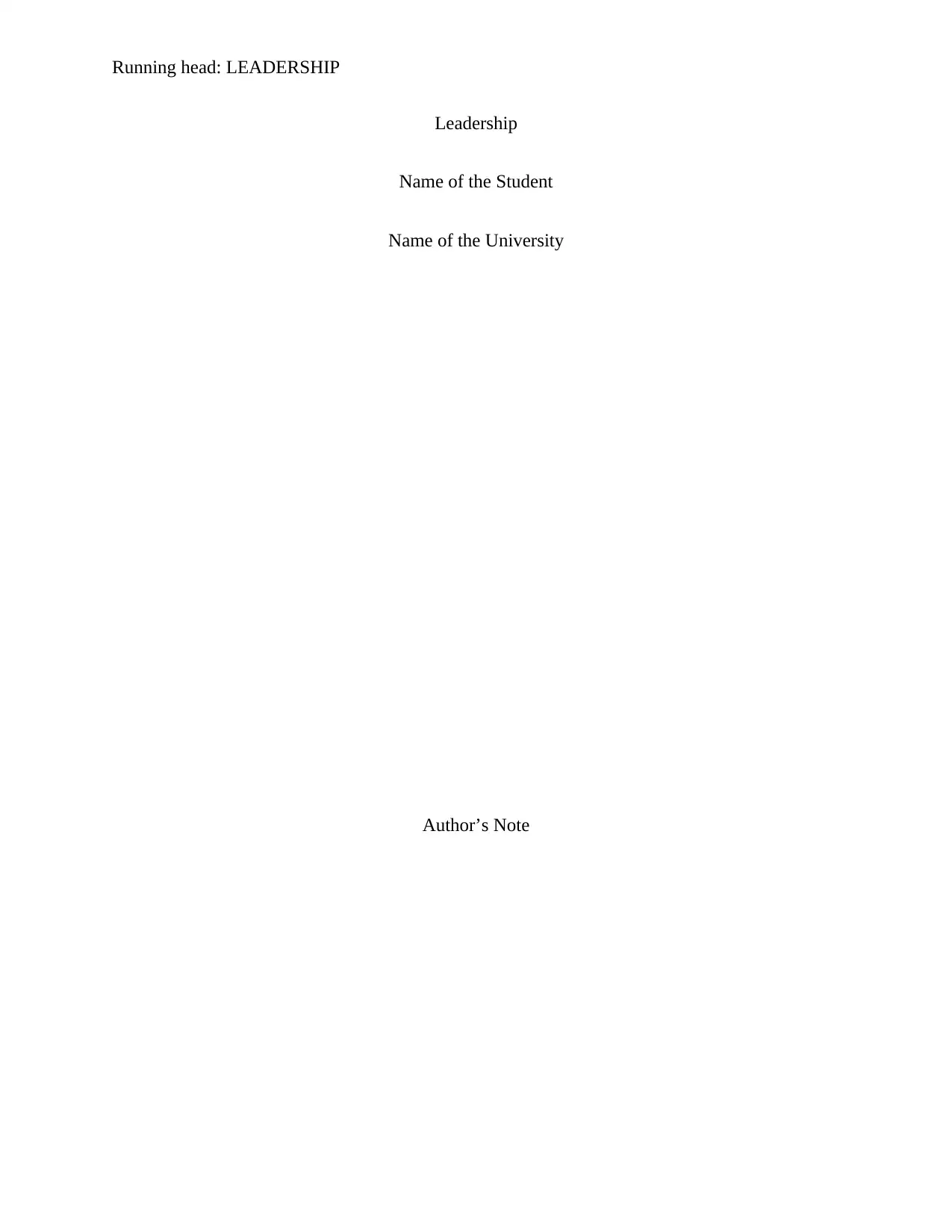
Running head: LEADERSHIP
Leadership
Name of the Student
Name of the University
Author’s Note
Leadership
Name of the Student
Name of the University
Author’s Note
Paraphrase This Document
Need a fresh take? Get an instant paraphrase of this document with our AI Paraphraser
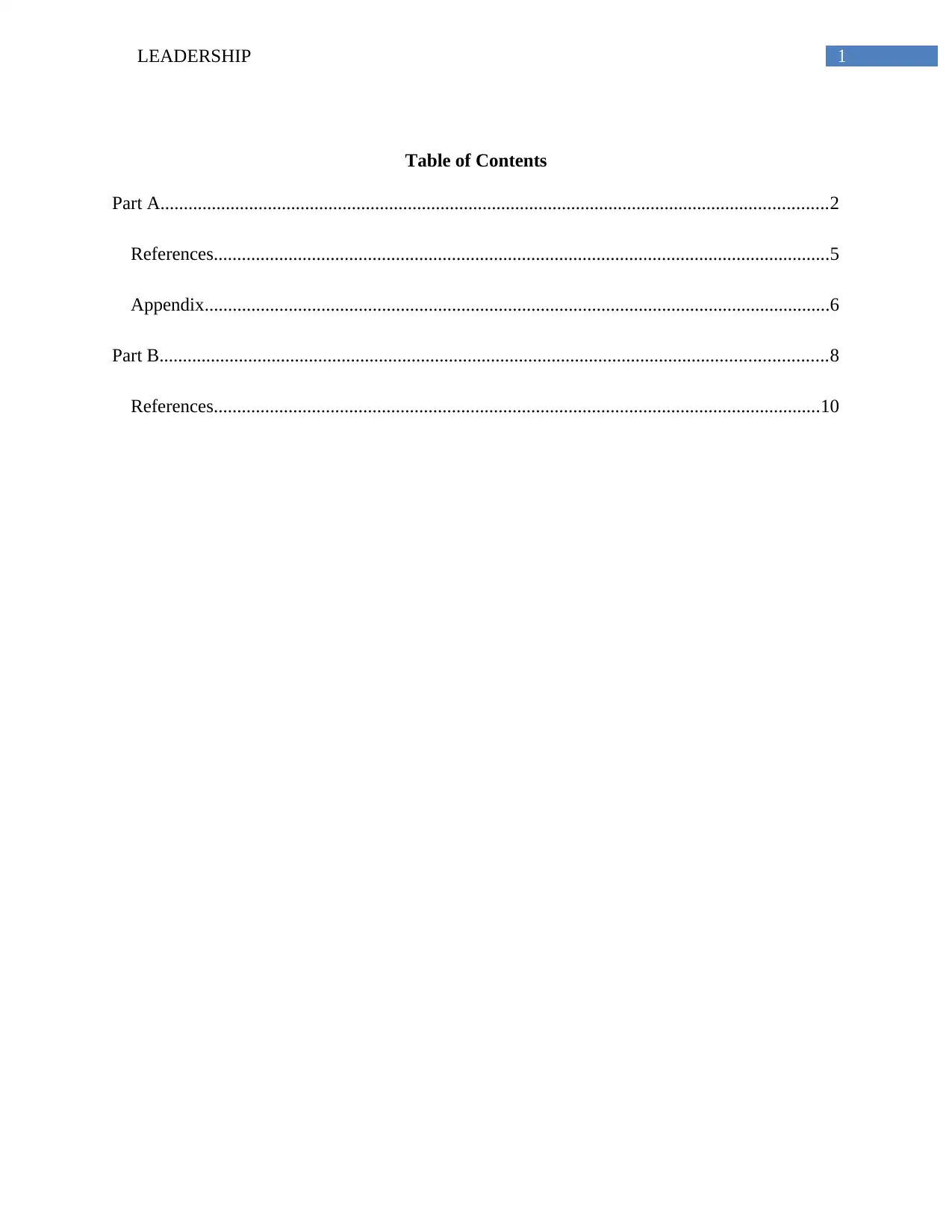
1LEADERSHIP
Table of Contents
Part A...............................................................................................................................................2
References....................................................................................................................................5
Appendix......................................................................................................................................6
Part B...............................................................................................................................................8
References..................................................................................................................................10
Table of Contents
Part A...............................................................................................................................................2
References....................................................................................................................................5
Appendix......................................................................................................................................6
Part B...............................................................................................................................................8
References..................................................................................................................................10
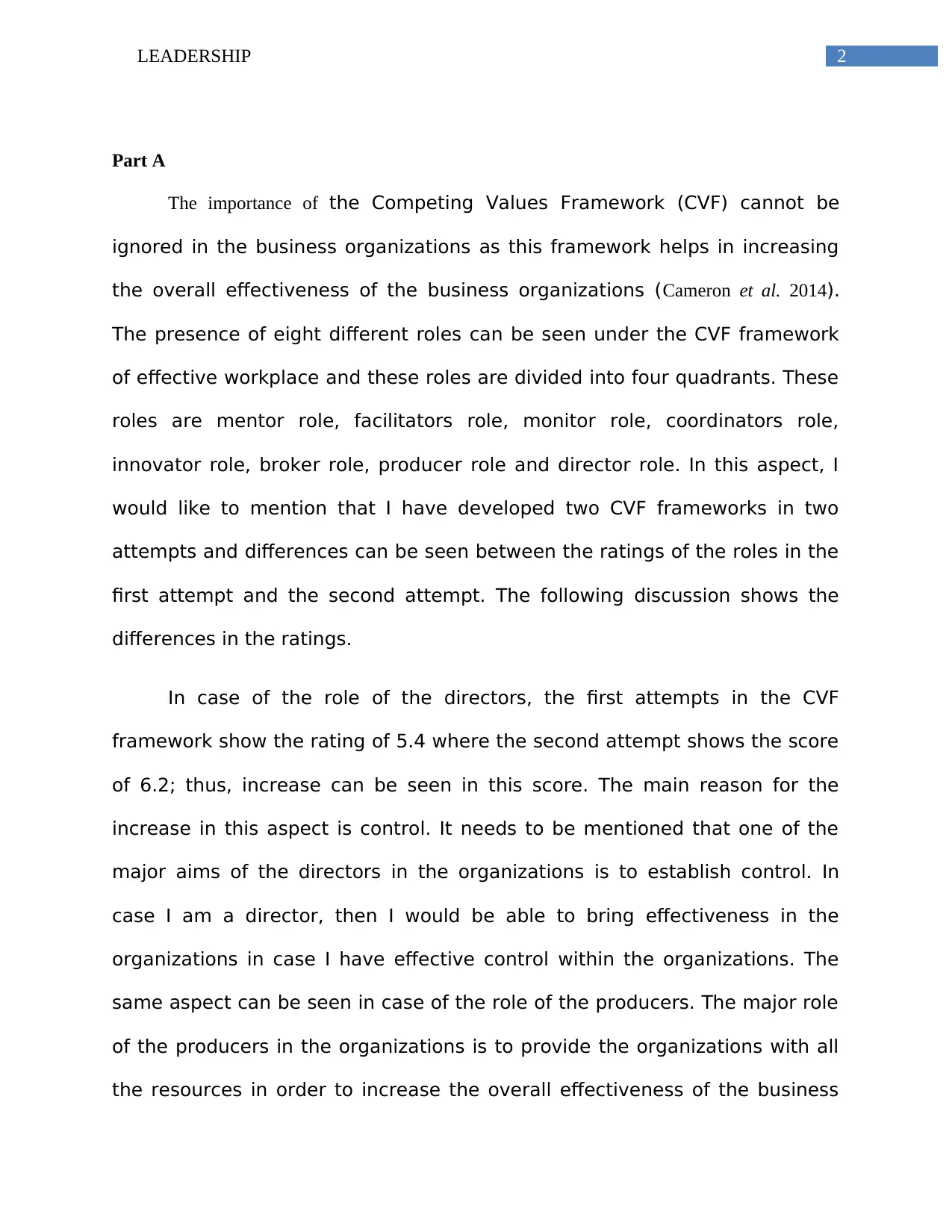
2LEADERSHIP
Part A
The importance of the Competing Values Framework (CVF) cannot be
ignored in the business organizations as this framework helps in increasing
the overall effectiveness of the business organizations (Cameron et al. 2014).
The presence of eight different roles can be seen under the CVF framework
of effective workplace and these roles are divided into four quadrants. These
roles are mentor role, facilitators role, monitor role, coordinators role,
innovator role, broker role, producer role and director role. In this aspect, I
would like to mention that I have developed two CVF frameworks in two
attempts and differences can be seen between the ratings of the roles in the
first attempt and the second attempt. The following discussion shows the
differences in the ratings.
In case of the role of the directors, the first attempts in the CVF
framework show the rating of 5.4 where the second attempt shows the score
of 6.2; thus, increase can be seen in this score. The main reason for the
increase in this aspect is control. It needs to be mentioned that one of the
major aims of the directors in the organizations is to establish control. In
case I am a director, then I would be able to bring effectiveness in the
organizations in case I have effective control within the organizations. The
same aspect can be seen in case of the role of the producers. The major role
of the producers in the organizations is to provide the organizations with all
the resources in order to increase the overall effectiveness of the business
Part A
The importance of the Competing Values Framework (CVF) cannot be
ignored in the business organizations as this framework helps in increasing
the overall effectiveness of the business organizations (Cameron et al. 2014).
The presence of eight different roles can be seen under the CVF framework
of effective workplace and these roles are divided into four quadrants. These
roles are mentor role, facilitators role, monitor role, coordinators role,
innovator role, broker role, producer role and director role. In this aspect, I
would like to mention that I have developed two CVF frameworks in two
attempts and differences can be seen between the ratings of the roles in the
first attempt and the second attempt. The following discussion shows the
differences in the ratings.
In case of the role of the directors, the first attempts in the CVF
framework show the rating of 5.4 where the second attempt shows the score
of 6.2; thus, increase can be seen in this score. The main reason for the
increase in this aspect is control. It needs to be mentioned that one of the
major aims of the directors in the organizations is to establish control. In
case I am a director, then I would be able to bring effectiveness in the
organizations in case I have effective control within the organizations. The
same aspect can be seen in case of the role of the producers. The major role
of the producers in the organizations is to provide the organizations with all
the resources in order to increase the overall effectiveness of the business
⊘ This is a preview!⊘
Do you want full access?
Subscribe today to unlock all pages.

Trusted by 1+ million students worldwide
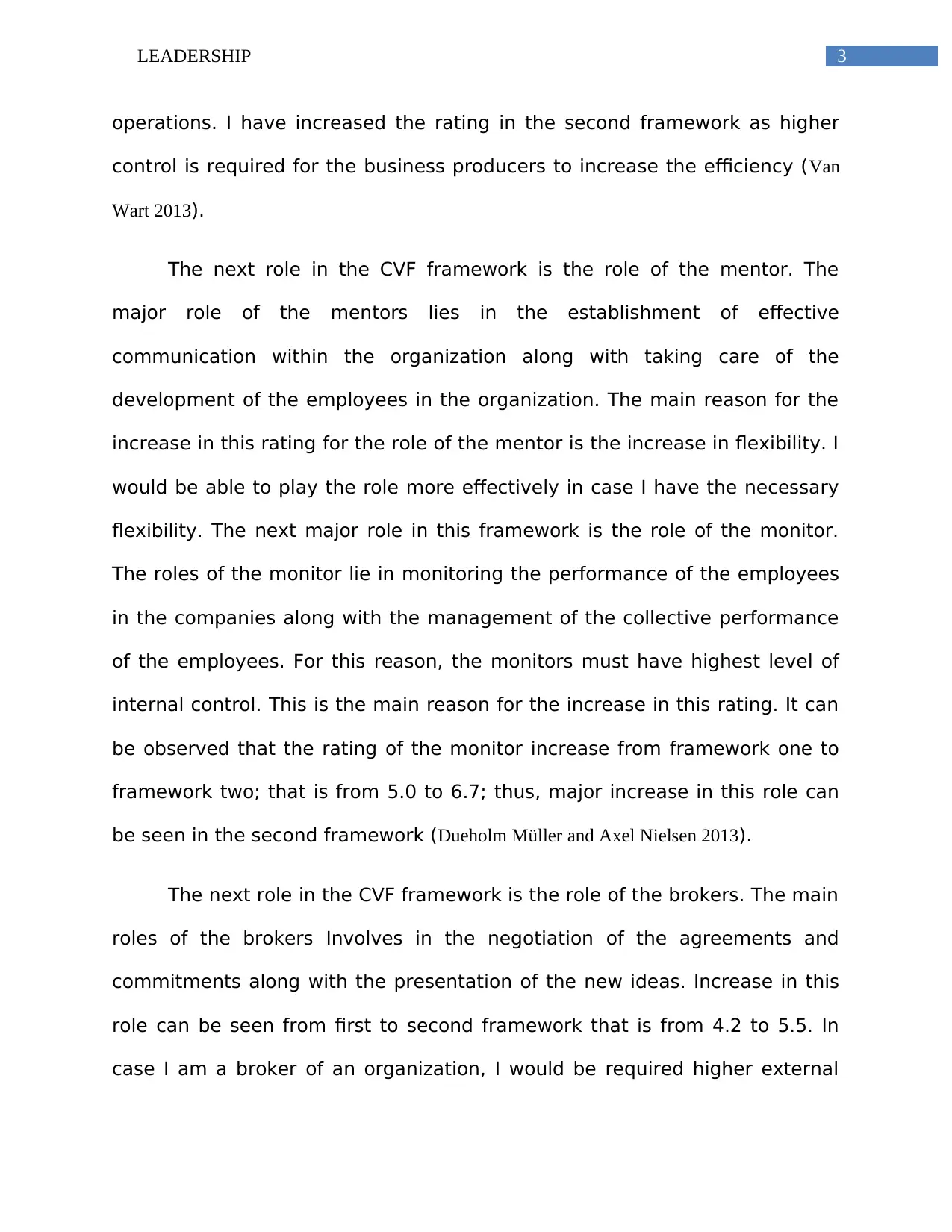
3LEADERSHIP
operations. I have increased the rating in the second framework as higher
control is required for the business producers to increase the efficiency (Van
Wart 2013).
The next role in the CVF framework is the role of the mentor. The
major role of the mentors lies in the establishment of effective
communication within the organization along with taking care of the
development of the employees in the organization. The main reason for the
increase in this rating for the role of the mentor is the increase in flexibility. I
would be able to play the role more effectively in case I have the necessary
flexibility. The next major role in this framework is the role of the monitor.
The roles of the monitor lie in monitoring the performance of the employees
in the companies along with the management of the collective performance
of the employees. For this reason, the monitors must have highest level of
internal control. This is the main reason for the increase in this rating. It can
be observed that the rating of the monitor increase from framework one to
framework two; that is from 5.0 to 6.7; thus, major increase in this role can
be seen in the second framework (Dueholm Müller and Axel Nielsen 2013).
The next role in the CVF framework is the role of the brokers. The main
roles of the brokers Involves in the negotiation of the agreements and
commitments along with the presentation of the new ideas. Increase in this
role can be seen from first to second framework that is from 4.2 to 5.5. In
case I am a broker of an organization, I would be required higher external
operations. I have increased the rating in the second framework as higher
control is required for the business producers to increase the efficiency (Van
Wart 2013).
The next role in the CVF framework is the role of the mentor. The
major role of the mentors lies in the establishment of effective
communication within the organization along with taking care of the
development of the employees in the organization. The main reason for the
increase in this rating for the role of the mentor is the increase in flexibility. I
would be able to play the role more effectively in case I have the necessary
flexibility. The next major role in this framework is the role of the monitor.
The roles of the monitor lie in monitoring the performance of the employees
in the companies along with the management of the collective performance
of the employees. For this reason, the monitors must have highest level of
internal control. This is the main reason for the increase in this rating. It can
be observed that the rating of the monitor increase from framework one to
framework two; that is from 5.0 to 6.7; thus, major increase in this role can
be seen in the second framework (Dueholm Müller and Axel Nielsen 2013).
The next role in the CVF framework is the role of the brokers. The main
roles of the brokers Involves in the negotiation of the agreements and
commitments along with the presentation of the new ideas. Increase in this
role can be seen from first to second framework that is from 4.2 to 5.5. In
case I am a broker of an organization, I would be required higher external
Paraphrase This Document
Need a fresh take? Get an instant paraphrase of this document with our AI Paraphraser
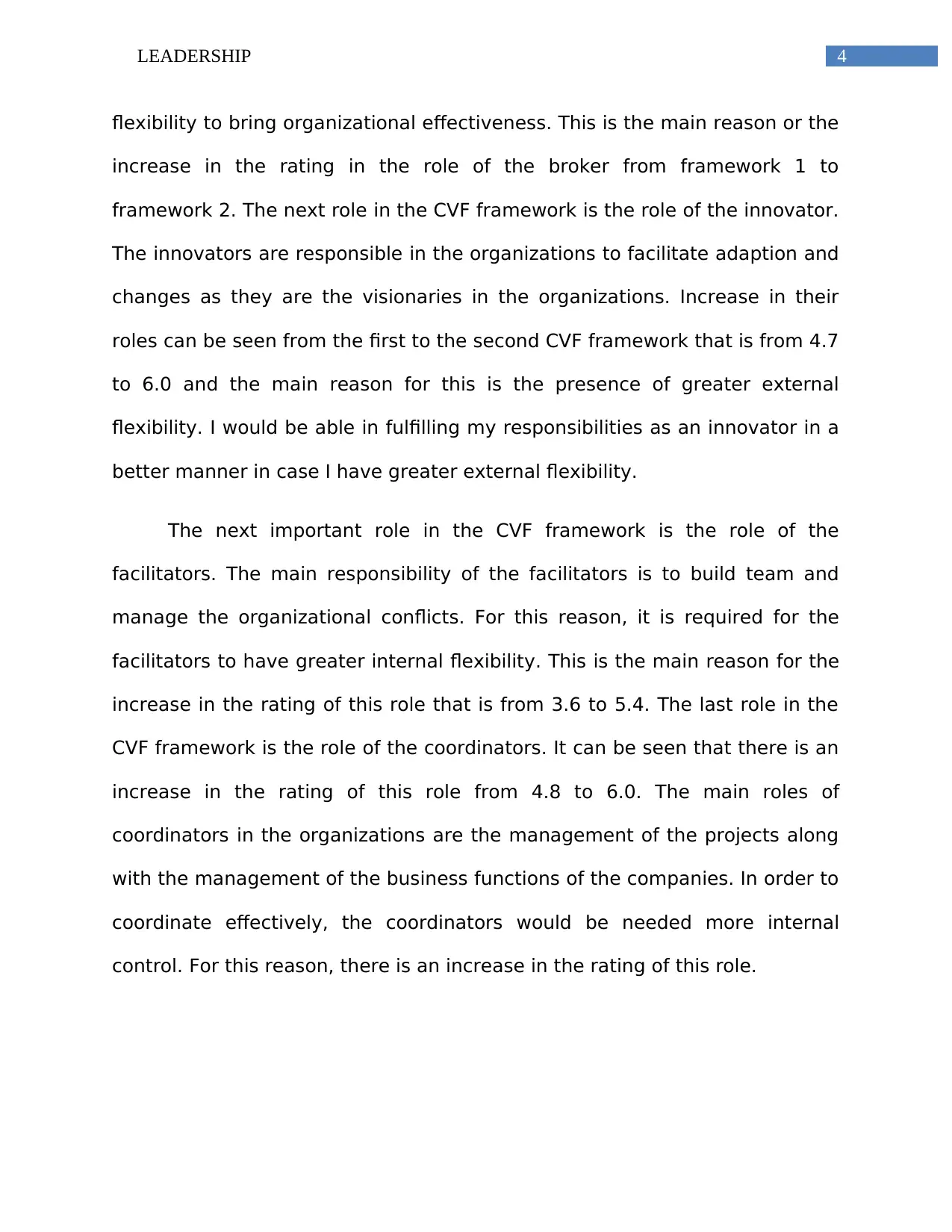
4LEADERSHIP
flexibility to bring organizational effectiveness. This is the main reason or the
increase in the rating in the role of the broker from framework 1 to
framework 2. The next role in the CVF framework is the role of the innovator.
The innovators are responsible in the organizations to facilitate adaption and
changes as they are the visionaries in the organizations. Increase in their
roles can be seen from the first to the second CVF framework that is from 4.7
to 6.0 and the main reason for this is the presence of greater external
flexibility. I would be able in fulfilling my responsibilities as an innovator in a
better manner in case I have greater external flexibility.
The next important role in the CVF framework is the role of the
facilitators. The main responsibility of the facilitators is to build team and
manage the organizational conflicts. For this reason, it is required for the
facilitators to have greater internal flexibility. This is the main reason for the
increase in the rating of this role that is from 3.6 to 5.4. The last role in the
CVF framework is the role of the coordinators. It can be seen that there is an
increase in the rating of this role from 4.8 to 6.0. The main roles of
coordinators in the organizations are the management of the projects along
with the management of the business functions of the companies. In order to
coordinate effectively, the coordinators would be needed more internal
control. For this reason, there is an increase in the rating of this role.
flexibility to bring organizational effectiveness. This is the main reason or the
increase in the rating in the role of the broker from framework 1 to
framework 2. The next role in the CVF framework is the role of the innovator.
The innovators are responsible in the organizations to facilitate adaption and
changes as they are the visionaries in the organizations. Increase in their
roles can be seen from the first to the second CVF framework that is from 4.7
to 6.0 and the main reason for this is the presence of greater external
flexibility. I would be able in fulfilling my responsibilities as an innovator in a
better manner in case I have greater external flexibility.
The next important role in the CVF framework is the role of the
facilitators. The main responsibility of the facilitators is to build team and
manage the organizational conflicts. For this reason, it is required for the
facilitators to have greater internal flexibility. This is the main reason for the
increase in the rating of this role that is from 3.6 to 5.4. The last role in the
CVF framework is the role of the coordinators. It can be seen that there is an
increase in the rating of this role from 4.8 to 6.0. The main roles of
coordinators in the organizations are the management of the projects along
with the management of the business functions of the companies. In order to
coordinate effectively, the coordinators would be needed more internal
control. For this reason, there is an increase in the rating of this role.
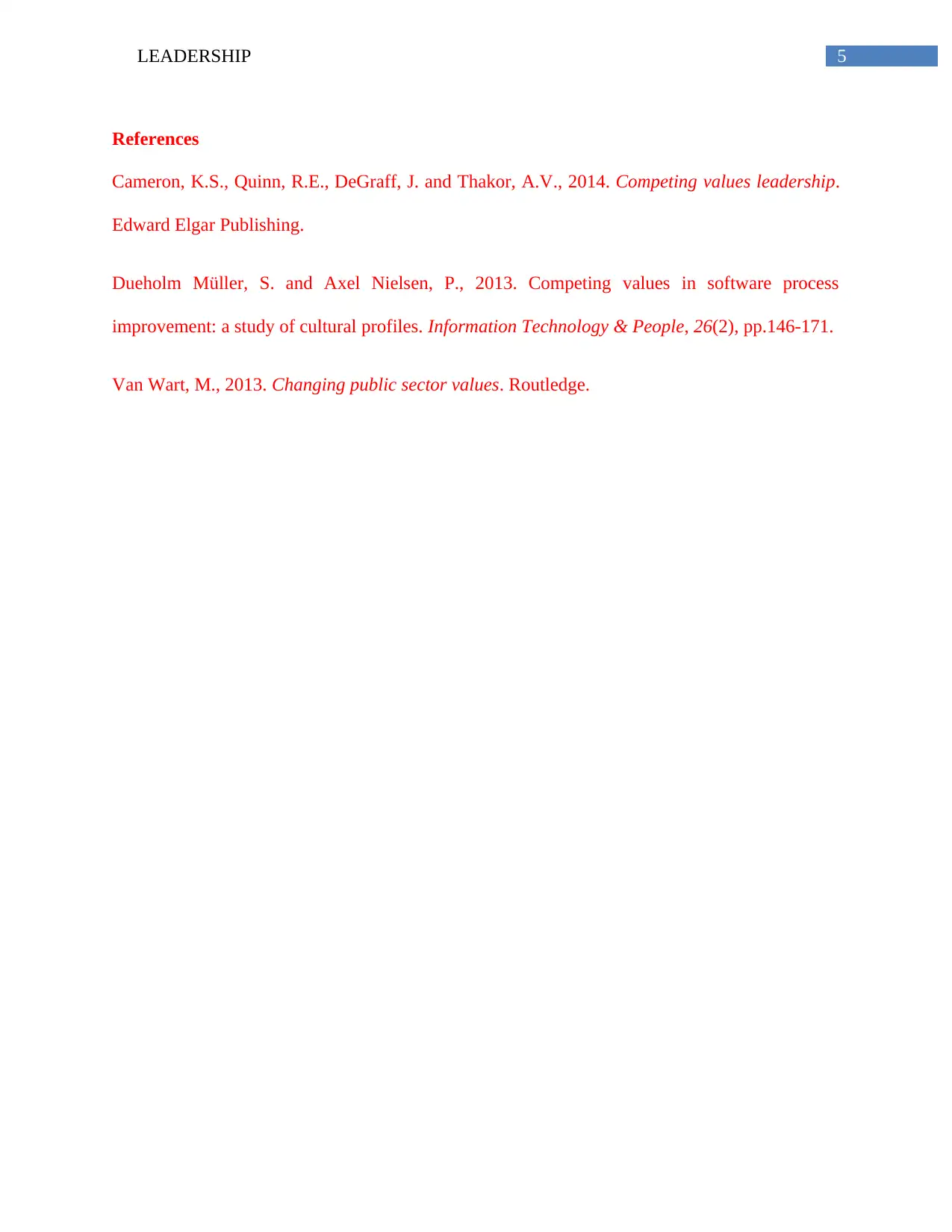
5LEADERSHIP
References
Cameron, K.S., Quinn, R.E., DeGraff, J. and Thakor, A.V., 2014. Competing values leadership.
Edward Elgar Publishing.
Dueholm Müller, S. and Axel Nielsen, P., 2013. Competing values in software process
improvement: a study of cultural profiles. Information Technology & People, 26(2), pp.146-171.
Van Wart, M., 2013. Changing public sector values. Routledge.
References
Cameron, K.S., Quinn, R.E., DeGraff, J. and Thakor, A.V., 2014. Competing values leadership.
Edward Elgar Publishing.
Dueholm Müller, S. and Axel Nielsen, P., 2013. Competing values in software process
improvement: a study of cultural profiles. Information Technology & People, 26(2), pp.146-171.
Van Wart, M., 2013. Changing public sector values. Routledge.
⊘ This is a preview!⊘
Do you want full access?
Subscribe today to unlock all pages.

Trusted by 1+ million students worldwide
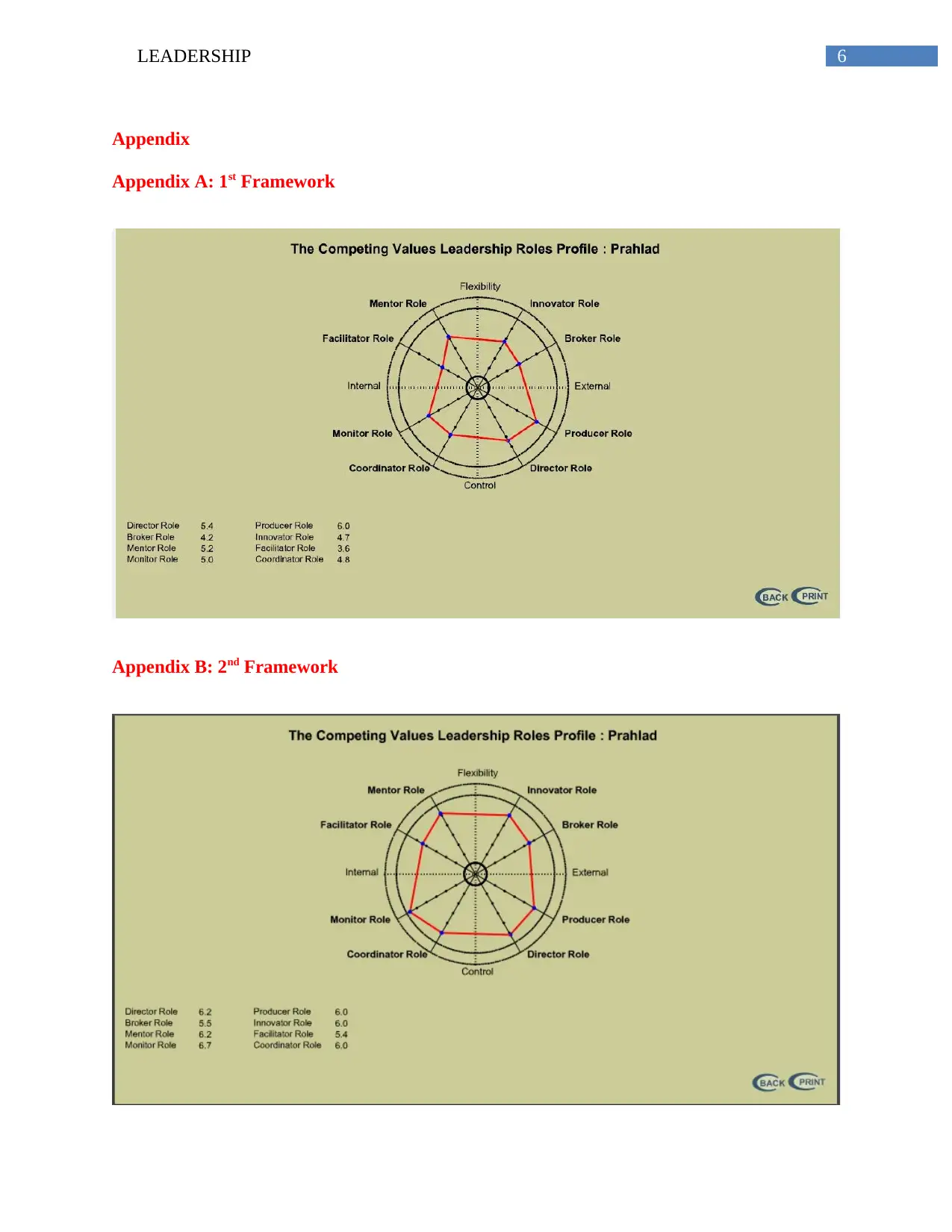
6LEADERSHIP
Appendix
Appendix A: 1st Framework
Appendix B: 2nd Framework
Appendix
Appendix A: 1st Framework
Appendix B: 2nd Framework
Paraphrase This Document
Need a fresh take? Get an instant paraphrase of this document with our AI Paraphraser
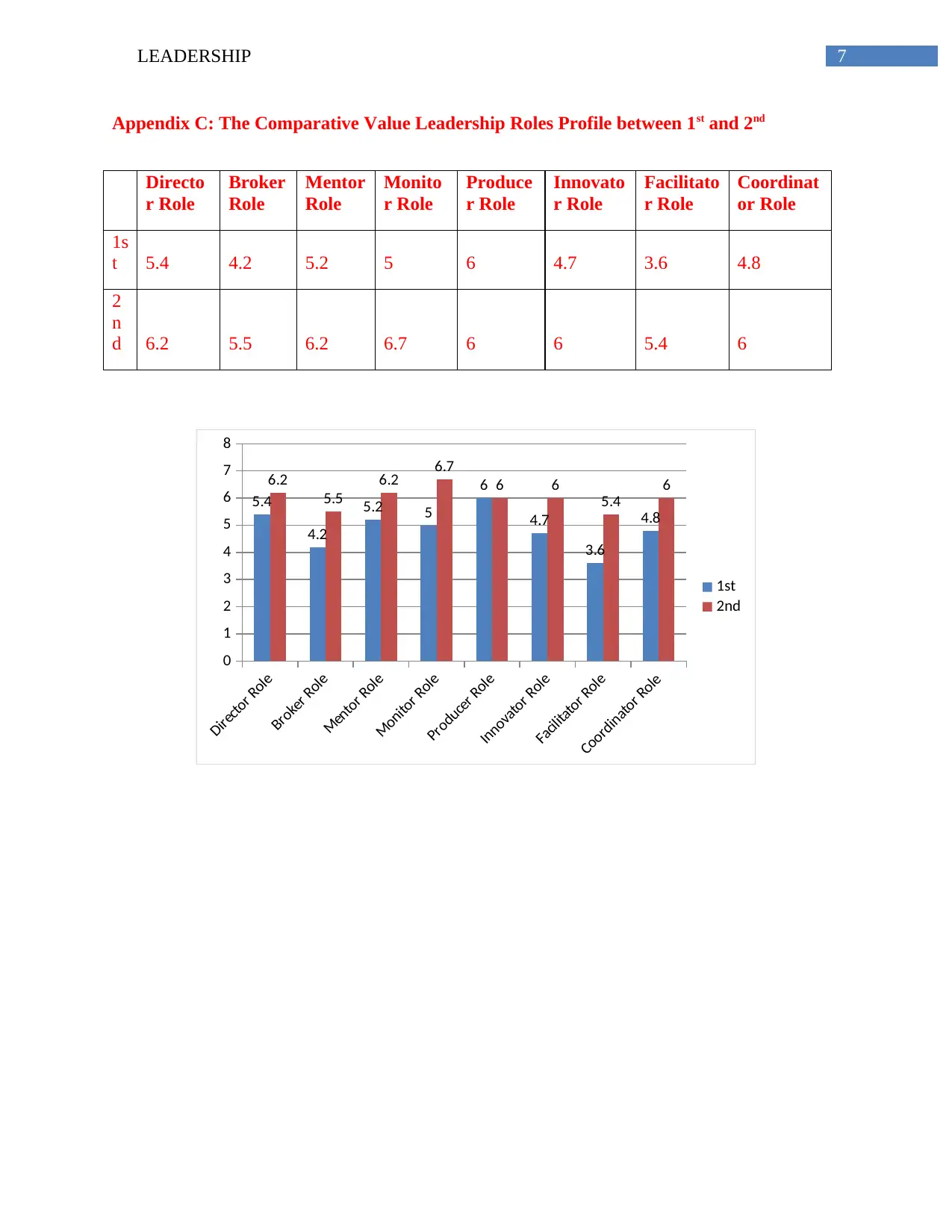
7LEADERSHIP
Appendix C: The Comparative Value Leadership Roles Profile between 1st and 2nd
Directo
r Role
Broker
Role
Mentor
Role
Monito
r Role
Produce
r Role
Innovato
r Role
Facilitato
r Role
Coordinat
or Role
1s
t 5.4 4.2 5.2 5 6 4.7 3.6 4.8
2
n
d 6.2 5.5 6.2 6.7 6 6 5.4 6
Director Role
Broker Role
Mentor Role
Monitor Role
Producer Role
Innovator Role
Facilitator Role
Coordinator Role
0
1
2
3
4
5
6
7
8
5.4
4.2
5.2 5
6
4.7
3.6
4.8
6.2
5.5
6.2 6.7
6 6
5.4
6
1st
2nd
Appendix C: The Comparative Value Leadership Roles Profile between 1st and 2nd
Directo
r Role
Broker
Role
Mentor
Role
Monito
r Role
Produce
r Role
Innovato
r Role
Facilitato
r Role
Coordinat
or Role
1s
t 5.4 4.2 5.2 5 6 4.7 3.6 4.8
2
n
d 6.2 5.5 6.2 6.7 6 6 5.4 6
Director Role
Broker Role
Mentor Role
Monitor Role
Producer Role
Innovator Role
Facilitator Role
Coordinator Role
0
1
2
3
4
5
6
7
8
5.4
4.2
5.2 5
6
4.7
3.6
4.8
6.2
5.5
6.2 6.7
6 6
5.4
6
1st
2nd
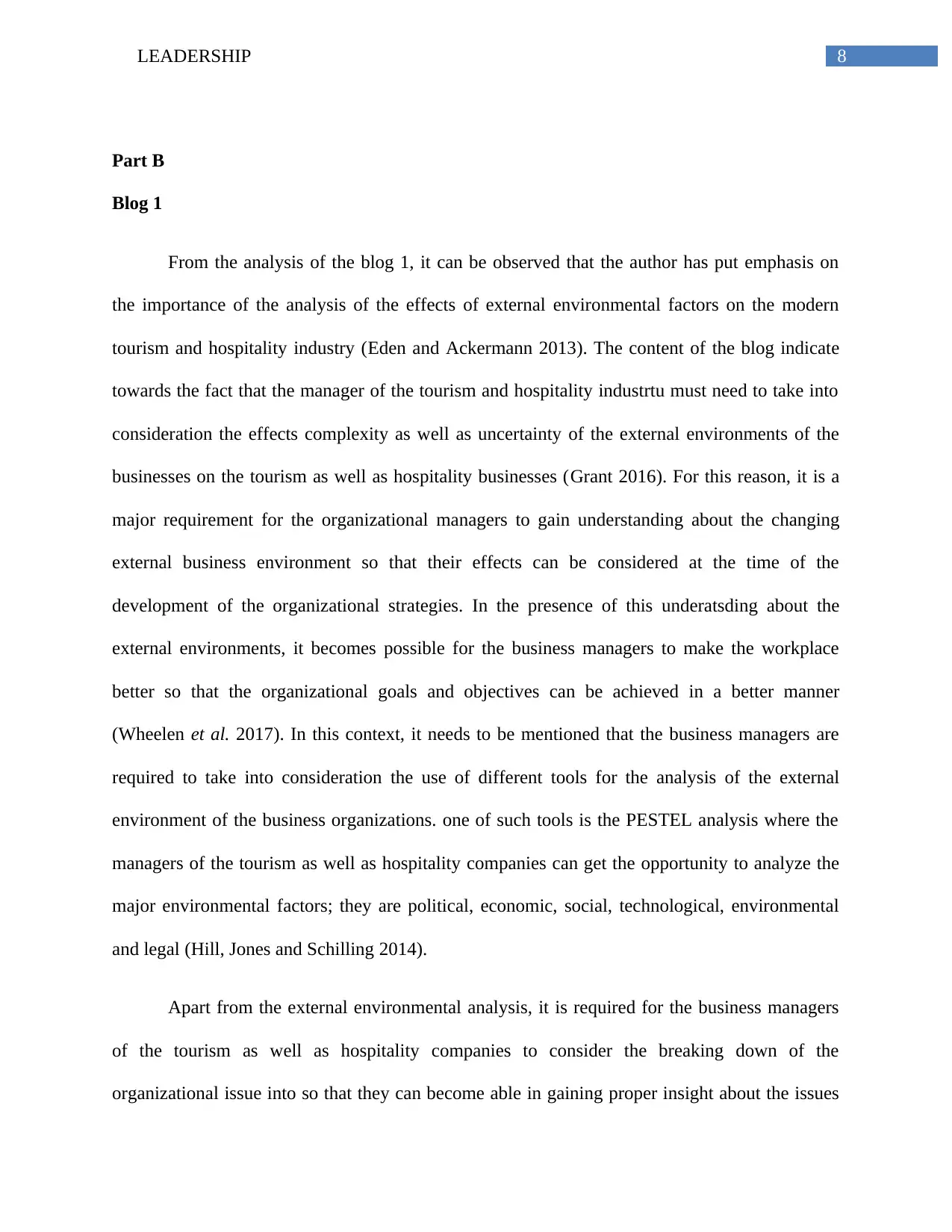
8LEADERSHIP
Part B
Blog 1
From the analysis of the blog 1, it can be observed that the author has put emphasis on
the importance of the analysis of the effects of external environmental factors on the modern
tourism and hospitality industry (Eden and Ackermann 2013). The content of the blog indicate
towards the fact that the manager of the tourism and hospitality industrtu must need to take into
consideration the effects complexity as well as uncertainty of the external environments of the
businesses on the tourism as well as hospitality businesses (Grant 2016). For this reason, it is a
major requirement for the organizational managers to gain understanding about the changing
external business environment so that their effects can be considered at the time of the
development of the organizational strategies. In the presence of this underatsding about the
external environments, it becomes possible for the business managers to make the workplace
better so that the organizational goals and objectives can be achieved in a better manner
(Wheelen et al. 2017). In this context, it needs to be mentioned that the business managers are
required to take into consideration the use of different tools for the analysis of the external
environment of the business organizations. one of such tools is the PESTEL analysis where the
managers of the tourism as well as hospitality companies can get the opportunity to analyze the
major environmental factors; they are political, economic, social, technological, environmental
and legal (Hill, Jones and Schilling 2014).
Apart from the external environmental analysis, it is required for the business managers
of the tourism as well as hospitality companies to consider the breaking down of the
organizational issue into so that they can become able in gaining proper insight about the issues
Part B
Blog 1
From the analysis of the blog 1, it can be observed that the author has put emphasis on
the importance of the analysis of the effects of external environmental factors on the modern
tourism and hospitality industry (Eden and Ackermann 2013). The content of the blog indicate
towards the fact that the manager of the tourism and hospitality industrtu must need to take into
consideration the effects complexity as well as uncertainty of the external environments of the
businesses on the tourism as well as hospitality businesses (Grant 2016). For this reason, it is a
major requirement for the organizational managers to gain understanding about the changing
external business environment so that their effects can be considered at the time of the
development of the organizational strategies. In the presence of this underatsding about the
external environments, it becomes possible for the business managers to make the workplace
better so that the organizational goals and objectives can be achieved in a better manner
(Wheelen et al. 2017). In this context, it needs to be mentioned that the business managers are
required to take into consideration the use of different tools for the analysis of the external
environment of the business organizations. one of such tools is the PESTEL analysis where the
managers of the tourism as well as hospitality companies can get the opportunity to analyze the
major environmental factors; they are political, economic, social, technological, environmental
and legal (Hill, Jones and Schilling 2014).
Apart from the external environmental analysis, it is required for the business managers
of the tourism as well as hospitality companies to consider the breaking down of the
organizational issue into so that they can become able in gaining proper insight about the issues
⊘ This is a preview!⊘
Do you want full access?
Subscribe today to unlock all pages.

Trusted by 1+ million students worldwide
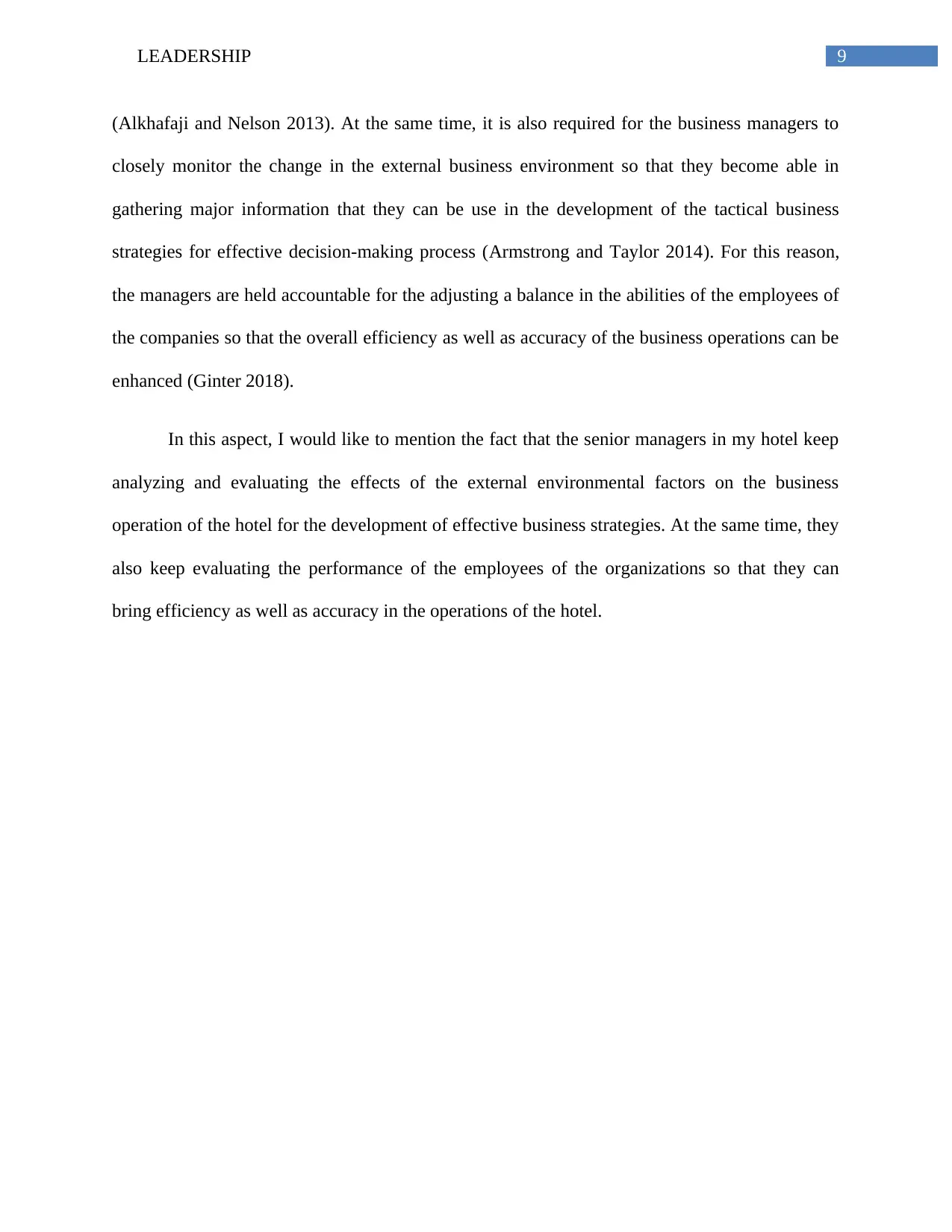
9LEADERSHIP
(Alkhafaji and Nelson 2013). At the same time, it is also required for the business managers to
closely monitor the change in the external business environment so that they become able in
gathering major information that they can be use in the development of the tactical business
strategies for effective decision-making process (Armstrong and Taylor 2014). For this reason,
the managers are held accountable for the adjusting a balance in the abilities of the employees of
the companies so that the overall efficiency as well as accuracy of the business operations can be
enhanced (Ginter 2018).
In this aspect, I would like to mention the fact that the senior managers in my hotel keep
analyzing and evaluating the effects of the external environmental factors on the business
operation of the hotel for the development of effective business strategies. At the same time, they
also keep evaluating the performance of the employees of the organizations so that they can
bring efficiency as well as accuracy in the operations of the hotel.
(Alkhafaji and Nelson 2013). At the same time, it is also required for the business managers to
closely monitor the change in the external business environment so that they become able in
gathering major information that they can be use in the development of the tactical business
strategies for effective decision-making process (Armstrong and Taylor 2014). For this reason,
the managers are held accountable for the adjusting a balance in the abilities of the employees of
the companies so that the overall efficiency as well as accuracy of the business operations can be
enhanced (Ginter 2018).
In this aspect, I would like to mention the fact that the senior managers in my hotel keep
analyzing and evaluating the effects of the external environmental factors on the business
operation of the hotel for the development of effective business strategies. At the same time, they
also keep evaluating the performance of the employees of the organizations so that they can
bring efficiency as well as accuracy in the operations of the hotel.
Paraphrase This Document
Need a fresh take? Get an instant paraphrase of this document with our AI Paraphraser
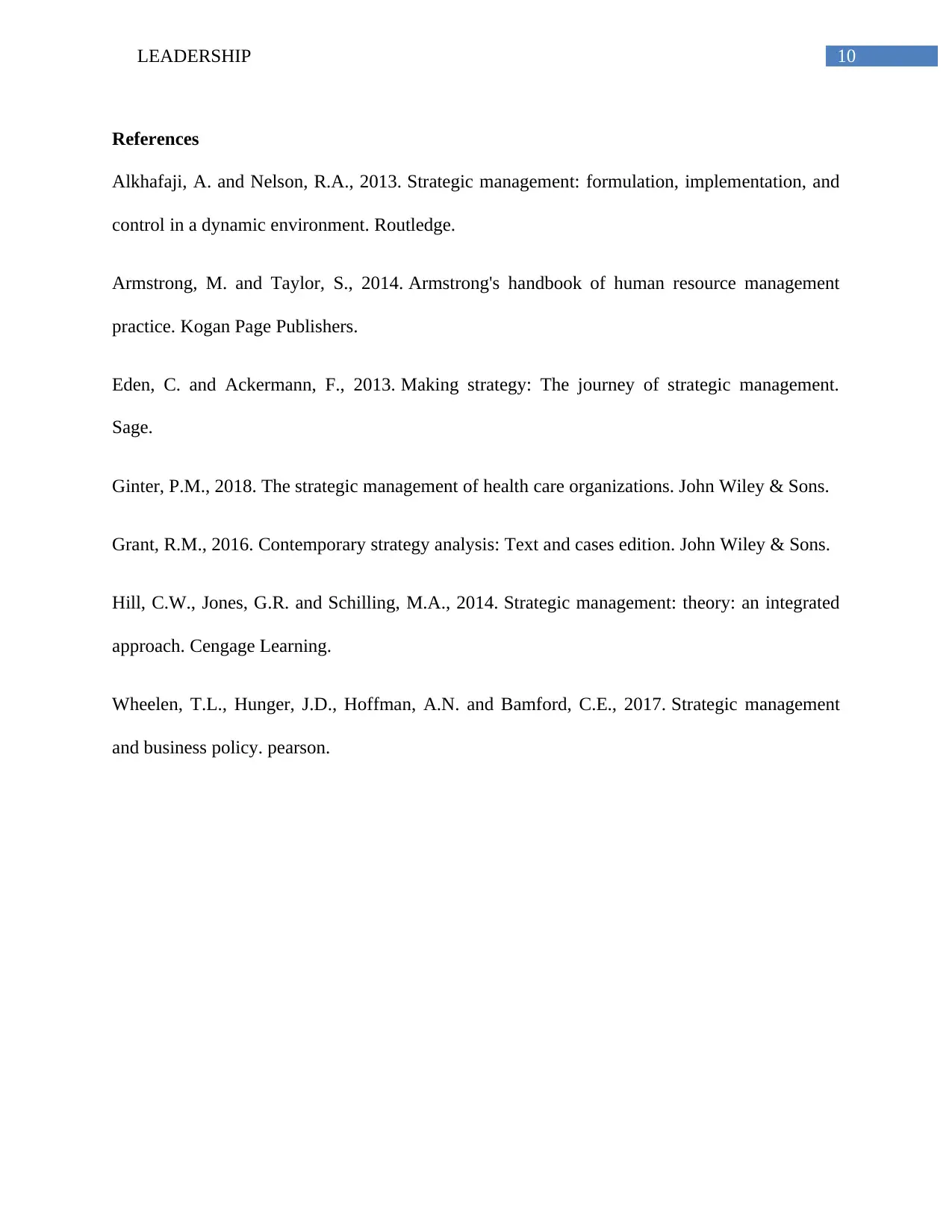
10LEADERSHIP
References
Alkhafaji, A. and Nelson, R.A., 2013. Strategic management: formulation, implementation, and
control in a dynamic environment. Routledge.
Armstrong, M. and Taylor, S., 2014. Armstrong's handbook of human resource management
practice. Kogan Page Publishers.
Eden, C. and Ackermann, F., 2013. Making strategy: The journey of strategic management.
Sage.
Ginter, P.M., 2018. The strategic management of health care organizations. John Wiley & Sons.
Grant, R.M., 2016. Contemporary strategy analysis: Text and cases edition. John Wiley & Sons.
Hill, C.W., Jones, G.R. and Schilling, M.A., 2014. Strategic management: theory: an integrated
approach. Cengage Learning.
Wheelen, T.L., Hunger, J.D., Hoffman, A.N. and Bamford, C.E., 2017. Strategic management
and business policy. pearson.
References
Alkhafaji, A. and Nelson, R.A., 2013. Strategic management: formulation, implementation, and
control in a dynamic environment. Routledge.
Armstrong, M. and Taylor, S., 2014. Armstrong's handbook of human resource management
practice. Kogan Page Publishers.
Eden, C. and Ackermann, F., 2013. Making strategy: The journey of strategic management.
Sage.
Ginter, P.M., 2018. The strategic management of health care organizations. John Wiley & Sons.
Grant, R.M., 2016. Contemporary strategy analysis: Text and cases edition. John Wiley & Sons.
Hill, C.W., Jones, G.R. and Schilling, M.A., 2014. Strategic management: theory: an integrated
approach. Cengage Learning.
Wheelen, T.L., Hunger, J.D., Hoffman, A.N. and Bamford, C.E., 2017. Strategic management
and business policy. pearson.
1 out of 11
Related Documents
Your All-in-One AI-Powered Toolkit for Academic Success.
+13062052269
info@desklib.com
Available 24*7 on WhatsApp / Email
![[object Object]](/_next/static/media/star-bottom.7253800d.svg)
Unlock your academic potential
Copyright © 2020–2025 A2Z Services. All Rights Reserved. Developed and managed by ZUCOL.





